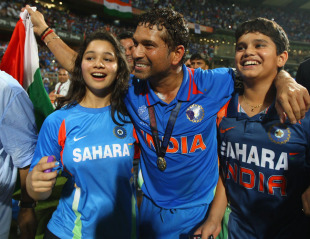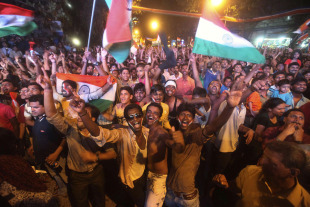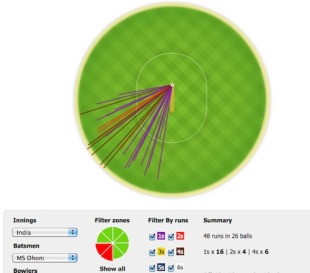India's cup of joy overflows
It was a day when the common man felt he was part of something special. A day when cherished dreams were realised
Nagraj Gollapudi at the Wankhede Stadium
April 3, 2011

| |||
Related Links | |||
Sachin Tendulkar walked out of the changing room and gestured to Sudhir Gautam to come up. Gautam is the thin, pale man with a shaven head and body covered in the Indian tri-colour. He is the man you would have seen recently with a miniature replica of the World Cup hanging atop his head. For at least half a decade now, Gautam has been Tendulkar's biggest fan, waving the Indian flag and blowing his conch shell at every venue Tendulkar plays. Today, Tendulkar decided to repay Gautam for his devotion.
No sooner had he realised that Tendulkar was calling, than Gautam jumped the electronic advertising hoarding and then skipped up the 30-odd stairs on to the corridor of the Indian changing room. All through his short journey he screamed in delight. Tendulkar shook hands with him, then embraced him and finally asked one of his team-mates to get the World Cup trophy. Zaheer Khan brought the cup outside with utmost care and held it tight. Gautam virtually snatched it out of the hands of the tournament's joint-highest wicket-taker. But Zaheer held on to the crown still. Eventually Gautam lifted the Cup with both hands as Zaheer let go. As soon as Gautam lifted the Cup and screamed "Indiaa", Tendulkar could not help but smile. He even clapped and was joined in appreciation by a few of his team-mates. The sweat on Tendulkar's face glistened under the floodlights, enhancing his joy of winning the World Cup .
It was a day when the common man felt he was part of something special. A day when the common man thought he had achieved something remarkable. A day when cherished dreams were realised. The first Saturday of April 2011 will remain unforgettable for a generation of Indians. Even as Gautam became the envy of people like me as he freely slipped in and out of the most sought after place in India, the team's dressing room, the players' families milled around, participating in the celebrations. Dhoni held his wife Sakshi close to him; Virender Sehwag hugged his wife Aarti and son Aryavir; Ashish Nehra's wife wore a replica of her husband's team shirt as she moved in and out of the dressing room. Gary Kirsten's wife Deborah joined the rest later. Yuvraj Singh, returning from the media confidence, started shaking his leg as he entered the dressing room. On his way inside, he had let out a screeching noise of jubilation.
The tempo in the dressing room had remained positive through the day and by the time MS Dhoni hit a spectacular six over long on against Nuwan Kulasekara, it had become a well of joy. As soon as Tendulkar found a private moment with his wife, Anjali, he embraced her tightly. It was a poignant moment. He knew how much she had sacrificed to support him in his endeavours. On the field, during the victory celebrations, he had hugged Yuvraj Singh, the man of the World Cup and burrowed his head into the tall allrounder's broad shoulders. Yuvraj had already declared he had dedicated the victory to Tendulkar. Virat Kohli had delivered the line of the evening when he said that for 21 years Tendulkar had shouldered the dreams of a billion Indians. Today youngsters such as Kohli and Suresh Raina carried Tendulkar over their shoulders during the lap of honour. Tears came easily to Tendulkar then.
Standing below, I was one of the hundreds who could not help but be stirred. It was my first World Cup. And watching the Indians celebrate in this familial atmosphere was extremely touching. On their way to the team bus, the players got a loud round of applause from hundreds of cops, who turned themselves in to fans for a few minutes by taking pictures. Some looked in awe at Tendulkar, who sat in the front seat with his wife sitting next to him. Both their kids sat on their laps. Some of the security people played with Sehwag's son, tapping on the window shield. When Yuvraj walked into the team bus with the Cup in hand, all the administrators and cops let him know how much they enjoyed his performances during the tournament. Gautam blowed his conch shell marking the departure of the bus. The cops yelled "Bharat mata ki, jai (long live India)".
Unfortunately, there was no victory ride back to the team hotel unlike in 2007 when Dhoni had lead India to victory in the World Twenty20. Also, disappointingly, the team hotel was out of bounds for the common man. Only guests were allowed. Barricades were put in place at all entry points leading up to the Taj Mahal Palace hotel in South Mumbai. The players had planned to celebrate the whole night and the Taj security did not want to take the chance of letting people inside.

| |||
It did not matter to the fans. Marine Drive, one of the most scenic spots in the city, became party central. Fans celebrated by blowing horns, trumpets, whistling, screaming into megaphones, peeping out of open-air cars, sometimes even standing by holding on to the window doors, climbing atop water tankers while waving the flag and dancing. It was a complete carnival atmosphere and the traffic came to a standstill as fireworks lit up the sky for more than two hours. For the first two hours after the match ended, it was hard to find public transport. Even guys like Dave Richardson, the ICC general manager, were forced to leave the Wankhede on foot, walking along with thousands of others
In the Trident hotel, there were many Indian fans, who had come from the UK and were enjoying their beer while chanting stuff like "Ala la la. Ala la la. Let's all do some bhangra." The hotel's coffee shop, normally pretty vacant, was full. The fans were not disappointed. They continued singing India's praises when they spotted Souuav Ganguly. "Sourav, Sourav" gave way to "Ganguly, Ganguly."
It was the Taj Mahal Palace and the Trident that were part of the terrorist attacks on November 26, 2008. Today, they wore a happy look. Both were dressing tonight to party; Saturday night fever had taken over.
On my way to try and sneak into the team hotel (a completely unsuccessful attempt), I passed a family of street dwellers comprising a husband, wife and two kids. All of them were fast asleep, immune to the cacophony of sound around them. Initially, I wondered how they could do that when India had won the World Cup. But the answer lay in what the man was wearing: he had the blue India shirt on. Perhaps he slept in the comfort of the hope that India would win the Cup. Perhaps he dreamt about it. When he wakes up, the dream would have been fulfilled. Tomorrow, all of India will wake up to a new feeling.
Nagraj Gollapudi is an assistant editor at ESPNcricinfo
© ESPN EMEA Ltd.
he partnerships that won the Cup
MS Dhoni showed his penchant for a run-chase yet again, while the middle order soaked up pressure quite superbly with two decisive stands
April 2, 2011
Text size: A | A

| |||
| Related Links Bulletin : Dhoni and Gambhir lead India to World Cup glory Matches: India v Sri Lanka at Mumbai Series/Tournaments: ICC Cricket World Cup | |||
At two wickets down for 31, chasing a target of 275 in a World Cup final, it all seemed to be headed in Sri Lanka's direction. In all ODIs since 2000, a first-innings total of 270 or more had been a winning score 394 times, while only 100 times had it been chased down. Add to that the pressures of the occasion - only twice in nine previous finals had the team batting second won a World Cup final, plus no side had ever lost their first wicket without a run on the board - and there was no doubt about which team held the whip at that stage.
That's when India's middle order stepped up, with a couple of stunning partnerships that completely turned the run-chase around. Virat Kohli and Gautam Gambhir's 83-run partnership consumed only 15.3 overs and resurrected India's innings, while the Gambhir-MS Dhoni stand more or less sealed the deal, adding an outstanding 109 off 19.4 overs to ensure the highest sucessful run-chase in a World Cup final.
The highlight of both those partnerships was the manner in which the batsmen soaked up the pressure, kept the risks to a minimum, and yet scored their runs at an excellent rate. In the third-wicket stand, Gambhir and Kohli scored only 32 out of 83 runs in fours and yet scored at 5.35 runs per over. Gambhir and Dhoni were even better, scoring 32 out of 109 in fours, yet achieving a run-rate of 5.54.
Going into this innings, Dhoni's performances with the bat had been disappointing, but there were no half-measures about the way he batted today. He showed, once again, his ability to excel in a run-chase: in 81 innings when he has batted second, Dhoni averaged 50.92, with 19 fifties and two hundreds. Among batsmen who've scored at least 2500 runs batting second, only Michael Bevan has a higher average.
Of the 91 runs he scored, more than half - 48 - came in the region between point and mid-off, several of them through back-foot punches off the spinners. Muttiah Muralitharan went for 22 off 22 balls, while Suraj Randiv conceded 14 off 15, as Dhoni repeatedly made room and played against the spin, carving the ball through cover and extra cover.
The other key contribution came from Gambhir, who clearly relishes playing Sri Lanka. Four of his nine ODI hundreds have come against them, and he almost made it a fifth with a superbly paced 97. One of the key tasks he accomplished was playing out Muralitharan and Lasith Malinga: 42 out of the 122 balls he faced were from them, and though he scored only 28 from those deliveries, he did his job by playing out a fair number.
| For wkt | Runs | Balls | 1s/ 2s | 4s/ 6s |
| 3rd | 83 | 93 | 27/ 9 | 8/ 0 |
| 4th | 109 | 118 | 49/ 11 | 8/ 0 |
Overall, there was little to choose between the Sri Lankan and Indian innings. India played seven fewer dots, but one of the impressive aspects of the Indian chase was the fact that they ran 24 twos, which shows the intent and aggression in the team during the chase.
| Team | Score | Dots | 1s/ 2s | 4s/ 6s |
| Sri Lanka | 274 for 6 | 146 | 108/ 17 | 27/ 2 |
| India | 277 for 4 | 139 | 99/ 24 | 25/ 2 |
The win meant that, for the first time in a World Cup final, a centurion ended up in the losing team. Clive Lloyd, Viv Richards, Aravinda de Silva, Ricky Ponting and Adam Gilchrist had all scored hundreds in winning causes, but Mahela Jayawardene's sublime 103 not out wasn't enough to seal the win for Sri Lanka. None of that was Jayawardene's fault, though, as he crafted a magnificent knock, scoring at at least a run a ball against each of the Indian bowlers. Zaheer Khan, so incisive in his opening spell, was taken apart by Jayawardene, who scored 23 from 14 balls off Zaheer.
The flawless manner in which Jayawardene batted made it look as if he was batting on another pitch. A comparison of his innings' stats with those of the other Sri Lankan batsmen illustrate the gulf: Jayawardene didn't score off less than 32% of the deliveries he faced; for the rest of his team, that percentage was more than 56.
This was also the first of Jayawardene's 14 ODI hundreds which ended in defeat. Considering how classy the knock was, it probably deserved a better result.
| Runs | Balls | Strike rate | Dot balls | Dot ball % | |
| Mahela Jayawardene | 103 | 88 | 117.04 | 28 | 31.82 |
| Rest of SL team | 159 | 214 | 74.30 | 120 | 56.07 |
